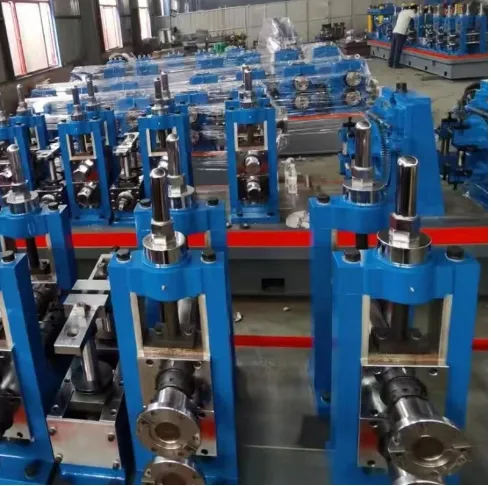Manual Pipe Rolling Machine: Analysis of Structure, Principle and Application
Manual Pipe Rolling Machine, As a relatively simple mechanical equipment, it plays an irreplaceable role in fields such as pipeline manufacturing and sheet metal processing. It manually bends metal sheets or other plastic materials into specific curvature arcs or complete circles, laying the foundation for subsequent welding, connection and other processes. This article will briefly analyze its structure, working principle, and application fields.

The basic structure of a Manual Pipe Rolling Machine typically includes three or more rollers, at least one of which can be adjusted
These rollers are arranged in parallel, forming a curved surface. The material to be processed is placed between the rollers, and the rollers are driven to move by rotating the handle or crank, causing the material to gradually deform under the squeezing and bending action of the rollers. By adjusting the distance and relative position between the rollers, the bending radius and final shape of the material can be controlled. The advantages of this ເຄື່ອງຕັດທໍ່ໂລຫະ structure are simplicity, reliability, easy maintenance, and relatively low skill requirements for the operator.
The working principle of the Manual Pipe Rolling Machine is based on the theory of plastic deformation of materials
When a material is subjected to external forces exceeding its yield strength, it will undergo plastic deformation, that is, permanent shape change. The pressure applied by the rollers of the rolling machine causes stress on the surface of the material. When the stress reaches and exceeds the yield strength of the material, the material will bend and deform under the action of the rollers. By gradually adjusting the position and pressure of the rollers, the material can be bent along the desired curve trajectory, ultimately forming the desired shape. It should be noted that the plastic deformation characteristics of different materials are different, so the pressure and speed of the rollers need to be adjusted according to the properties of the material during the rolling process to avoid defects such as cracks and wrinkles in the material.
Manual Pipe Rolling Machine has a wide range of applications, especially in situations where precision is not required and batch sizes are small, it has significant advantages
For example, in pipeline installation engineering, it can be used to bend pipelines to adapt to complex spatial layouts; In the sheet metal processing industry, it can be used to make cylindrical parts such as chimneys, ventilation ducts, etc; In the DIY field, it can be used to make various decorations and crafts. Although ເຄື່ອງຕັດທໍ່ໂລຫະ have a gap in efficiency and accuracy compared to automated rolling equipment, their flexibility and ease of use cannot be replaced by other devices in some special cases.
In summary, the MS pipe welding machine plays an important role in many fields due to its simple structure and convenient operation. Although automated rolling equipment has been widely used with the advancement of technology, ເຄື່ອງຕັດທໍ່ bevel still have their unique value and are indispensable tools in some specific situations. In the future, with the continuous emergence of new materials and processes, Manual Pipe Rolling Machines will also continue to improve in design and manufacturing to adapt to more complex and diverse application needs.
Manual Pipe Rolling Machine FAQs
What is Manual Pipe Rolling Machine?
Manual Pipe Rolling Machine is a device that bends metal sheets or pipes into circular or spiral shapes through manual operation, such as a handle or lever. It is usually used for small-scale processing or on-site operations, suitable for forming materials such as steel, aluminum, copper, etc.
What scenarios is the Manual Pipe Rolling Machine suitable for?
Small batch production or maintenance operations.
The construction site requires rapid bending of pipes or profiles.
In situations where the budget is limited and high-precision bending is not required.
What is the maximum bending thickness and diameter of the Manual Pipe Rolling Machine?
Depending on the machine model, typically:
Maximum bending thickness: 1mm~6mm (low carbon steel).
Maximum pipeline diameter: usually ranging from 20mm to 150mm.
(Please refer to the equipment specifications for details. Heavy manual models may support larger sizes.)
What should be noted when operating the Manual Pipe Rolling Machine?
Ensure that the material surface is free of cracks or defects to avoid breakage.
Apply force slowly and evenly to prevent deformation caused by excessive bending.
Use lubricants to reduce friction and protect molds and materials.
Wear gloves and goggles to prevent metal shavings from splashing.
What are the advantages and disadvantages of Manual Pipe Rolling Machine compared to hydraulic/CNC pipe rolling machine?
Advantages: Low cost, portable, no need for electricity, suitable for simple tasks.
Disadvantages: high labor intensity, low precision (relying on operator experience), slow efficiency, not suitable for mass production.
-
The World of Pipe and Tube Machinery Manufacturers: Precision and Innovationຂ່າວAug.12,2025
-
Revolutionize Your Pipe Manufacturing and Welding with Our Exceptional Machineryຂ່າວAug.12,2025
-
Navigating Pipe Machinery Costs: A Guide to Pricing for Key Equipmentຂ່າວAug.12,2025
-
Essential Pipe Fabrication Equipment: Cutting, Welding, and Support Solutionsຂ່າວAug.12,2025
-
Comprehensive Pipe Processing Machinery: From Cutting to Extrusionຂ່າວAug.12,2025
-
Advanced Pipe Fabrication Tools: Cutting, Beveling, and Welding Solutionsຂ່າວAug.12,2025


